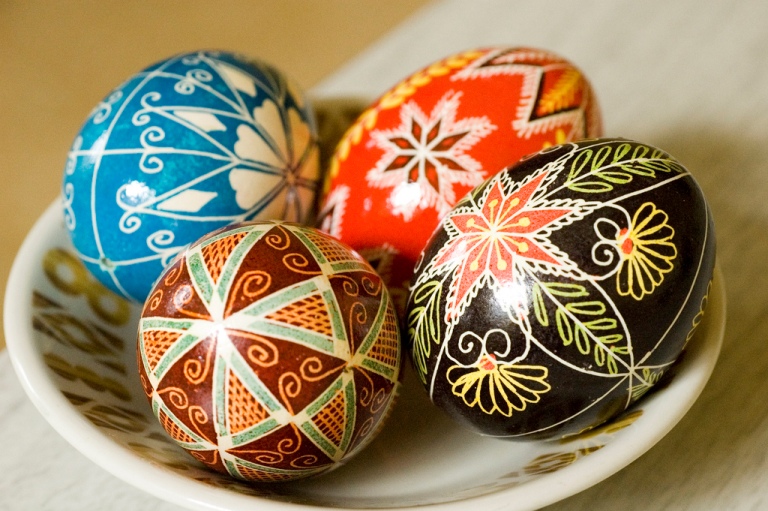 Ukrainian art is full of special, unique and centuries-old traditions, symbols and metaphorical elements. Most works of art have encoded symbols that vividly demonstrate the entire spectrum of mythopoetic ideas of our ancestors about the universe and cosmos with its measured and completely ordered structure. According to the beliefs of the recognized scientist M. Kostomarov, a symbol acts as a visual and figurative expression of certain moral ideas reflected in objects of physical nature. However, such images are fully endowed with spiritual properties. According to the statements of the same M. Kostomarov, the physical nature of things is embodied through divine love and creative ideas are embodied in the most masterful forms. According to the observations of Academician Vernadsky, works of folk art, in which artistic interpretation is closely intertwined with historical and social phenomena, best reflect the life and development of a given people in a particular period of time. Through the study of such works, one can study in detail and come closer to understanding the folk soul. According to his definitions, the depth of symbolism of folk art reveals the Cosmos, which passes through the consciousness of the human being.
Ukrainian art is full of special, unique and centuries-old traditions, symbols and metaphorical elements. Most works of art have encoded symbols that vividly demonstrate the entire spectrum of mythopoetic ideas of our ancestors about the universe and cosmos with its measured and completely ordered structure. According to the beliefs of the recognized scientist M. Kostomarov, a symbol acts as a visual and figurative expression of certain moral ideas reflected in objects of physical nature. However, such images are fully endowed with spiritual properties. According to the statements of the same M. Kostomarov, the physical nature of things is embodied through divine love and creative ideas are embodied in the most masterful forms. According to the observations of Academician Vernadsky, works of folk art, in which artistic interpretation is closely intertwined with historical and social phenomena, best reflect the life and development of a given people in a particular period of time. Through the study of such works, one can study in detail and come closer to understanding the folk soul. According to his definitions, the depth of symbolism of folk art reveals the Cosmos, which passes through the consciousness of the human being.
The worldview of Ukrainians is characterized by the use of various art objects that fully reflect universal phenomena and realities. So, if you pay attention to such common and familiar objects as an Easter egg or a towel, you can trace the fullness of important symbols and general knowledge of our ancestors on a not very large plane. For example, an Easter egg personifies the cosmic Paradise, which symbolizes a kind of generalized gene of life, a kind of celestial sphere from which stars and planets appear. If we clarify this symbol in more detail, the Sun is depicted as a kind of vessel, and other spherical cosmic bodies as the bosom of the Universe. Towels, in turn, reflected on their canvases encrypted in cryptographic signs and symbols knowledge about the general structure of the Universe and the place of man in it. One of the key symbols of Ukrainian embroidered towels - the Tree of Life is identified with the Center of Life and clearly shows the hierarchical vision of the structure of being of our ancestors. Towel embroideries closely intertwine folk ideas about the temporal-spatial structure and model of the universe, with worldview orientations in space and the orderliness of the surrounding world, presented in the form of aesthetically formed preferences and spiritual directions.
 Traditionally, the Ukrainian worldview is reflected in the form of images that unite three planes of existence: heaven, earth and the afterlife, that is, the Upper, Intermediate and Valley. The most common images of such a trinity are, of course, the World Tree or, as it is often called, the Tree of Life. Perhaps such a prevalence of this image is due to a certain and clearly expressed three-tieredness of such an image: top-trunk-flowerpot or roots of the tree. Along with the Tree of Life, there is usually a bird that acts as the guardian of this tree and personifies a pure and bright soul. The World Tree is canonically depicted as appearing from a flowerpot or bowl, thereby clearly indicating the origin of its roots from a certain container-womb, analogous to the universe. According to Ukrainian mythology, it is from a jug that the World and the Universe originate.
Traditionally, the Ukrainian worldview is reflected in the form of images that unite three planes of existence: heaven, earth and the afterlife, that is, the Upper, Intermediate and Valley. The most common images of such a trinity are, of course, the World Tree or, as it is often called, the Tree of Life. Perhaps such a prevalence of this image is due to a certain and clearly expressed three-tieredness of such an image: top-trunk-flowerpot or roots of the tree. Along with the Tree of Life, there is usually a bird that acts as the guardian of this tree and personifies a pure and bright soul. The World Tree is canonically depicted as appearing from a flowerpot or bowl, thereby clearly indicating the origin of its roots from a certain container-womb, analogous to the universe. According to Ukrainian mythology, it is from a jug that the World and the Universe originate.
Investigating the theme of the World Tree, folklorist K. Sosenko noted that the idea of such a Tree is perceived by the people as the main and first factor in the creation of the world. A vivid confirmation of this hypothesis are Ukrainian carols, which are an echo of the ancient traditions of Indo-European peoples. In the images of carols, the World Tree appears in the form of the most ancient verbal symbol, such a tree stands in the middle of the blue sea, the symbolism of one of the primordial verses is traced in the image of the sea, and on this tree three birds consult how to “create” the world. Then, through the use of allegories and metaphors, a wonderful mystery of the creation of the World appears: the birds dive into the depths of the sea and take out fine sand from the bottom, which will later become black earth, a golden stone, which acts as a symbol for the subsequent appearance of the sun, moon and stars in the clear blue sky. However, in some sources there is a slightly different variation of the appearance of the sky from a blue stone. So, according to the works of I. Nechuy-Levytskyi, blue and gold colors in Ukrainian mythology mean light. Thus, in his work "The Worldview of the Ukrainian People," Nechuy-Levytskyi interprets the "blue sea" as a symbol of the blue celestial space, in the middle of which clouds float.
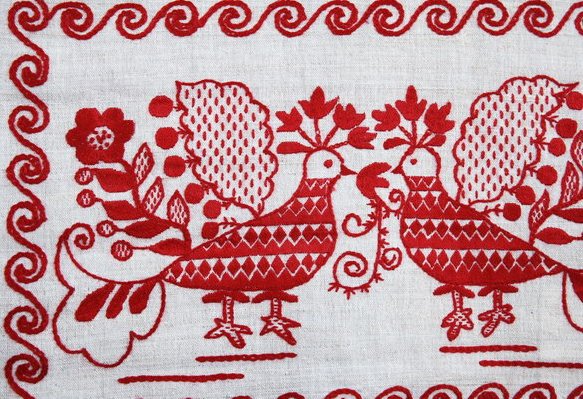 The basis of the Universe, a kind of core of the universe, a symbol of the cosmos, a source of life and harmony according to the beliefs of the ancients is the Sky itself. Having studied the semantics of the word sky in different languages and peoples, one can trace an almost identical interpretation, for example, "sky" means: life, number, harmony, order, navel, middle, this is especially clearly seen in the English, Irish, Latin, Hittite and Welsh languages. Quite often the word "sky" is consonant and is used as a variant of a synonym for the concept of "God", and representatives of the amphibian species act as symbols of deities and the Universe in general. Also quite often the meaning of "sky" is correlated with the concepts of "direction of the world", "abyss", "vault". If we focus on the myths of the peoples of the world, we can trace the imaginary connection of the sky with the world waters in which all celestial bodies float, and the sky itself was created from stone, liquid and metal. According to the beliefs of ancient Ukrainians, the Sky is a river or ocean in the expanses of which the Sun travels. Sometimes the Sky was identified with a cow, which was called the celestial cow and considered a celestial being.
The basis of the Universe, a kind of core of the universe, a symbol of the cosmos, a source of life and harmony according to the beliefs of the ancients is the Sky itself. Having studied the semantics of the word sky in different languages and peoples, one can trace an almost identical interpretation, for example, "sky" means: life, number, harmony, order, navel, middle, this is especially clearly seen in the English, Irish, Latin, Hittite and Welsh languages. Quite often the word "sky" is consonant and is used as a variant of a synonym for the concept of "God", and representatives of the amphibian species act as symbols of deities and the Universe in general. Also quite often the meaning of "sky" is correlated with the concepts of "direction of the world", "abyss", "vault". If we focus on the myths of the peoples of the world, we can trace the imaginary connection of the sky with the world waters in which all celestial bodies float, and the sky itself was created from stone, liquid and metal. According to the beliefs of ancient Ukrainians, the Sky is a river or ocean in the expanses of which the Sun travels. Sometimes the Sky was identified with a cow, which was called the celestial cow and considered a celestial being.
For people who lived in the times of the mytho-epic era, the Sky was represented as a dome, a hemisphere, a cover, a cover that protected them. The protection was also strengthened by countless heavenly forces, with the help of which the Divine will was realized. To this day, on household items: carpets, shirts, towels, Easter eggs, images of the Rozhanitsa or the Mother Goddess with raised or lowered hands have survived, depending on the position of the hands, such images blessed either the sky or the earth. With the adoption of Christianity, these images were transformed into two hypostases of the Most Holy Theotokos: the Protection and the Oranta.
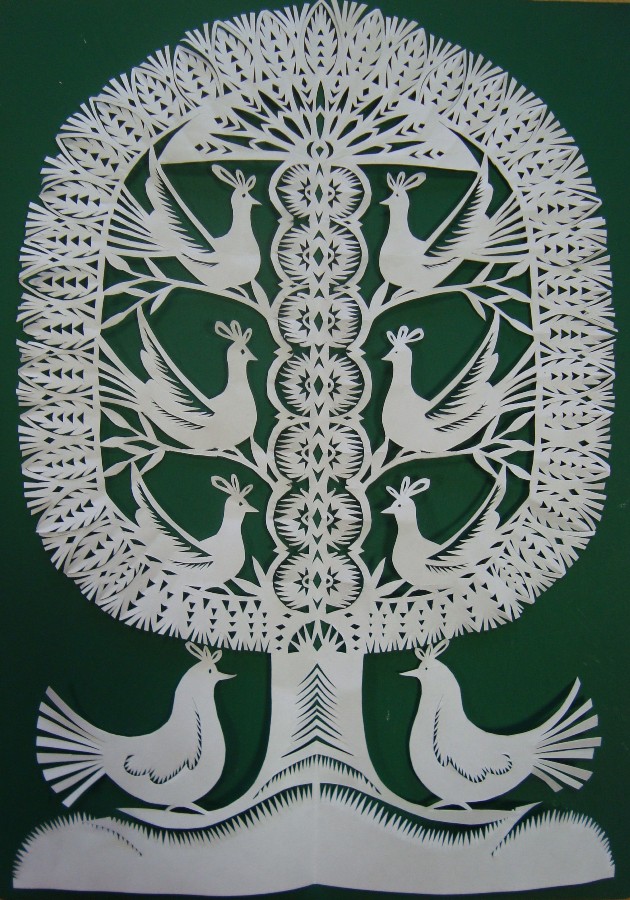 The sky itself was considered multi-tiered, usually up to 8 spheres, and was divided into a space for atmospheric phenomena and birds, which was called "air" and a place for the divine house and throne - "high". P. Chubynsky (a famous folklorist, ethnographer and local historian) recorded the following folk belief: there are seven blue clouds, and the eighth - the just sky, where God sits on his golden chair, and angels fly nearby, is red in color. The just sky sometimes opens, but this happens only on some "occasion": war, famine or reconciliation. In such an open sky, people saw the figure of a man with a sword - which announced war, or with a bowl - it was a sign of a good harvest, and the heads of angels were also seen next to this figure. It was at such a moment that it was necessary to ask the Lord for the salvation of the soul.
The sky itself was considered multi-tiered, usually up to 8 spheres, and was divided into a space for atmospheric phenomena and birds, which was called "air" and a place for the divine house and throne - "high". P. Chubynsky (a famous folklorist, ethnographer and local historian) recorded the following folk belief: there are seven blue clouds, and the eighth - the just sky, where God sits on his golden chair, and angels fly nearby, is red in color. The just sky sometimes opens, but this happens only on some "occasion": war, famine or reconciliation. In such an open sky, people saw the figure of a man with a sword - which announced war, or with a bowl - it was a sign of a good harvest, and the heads of angels were also seen next to this figure. It was at such a moment that it was necessary to ask the Lord for the salvation of the soul.
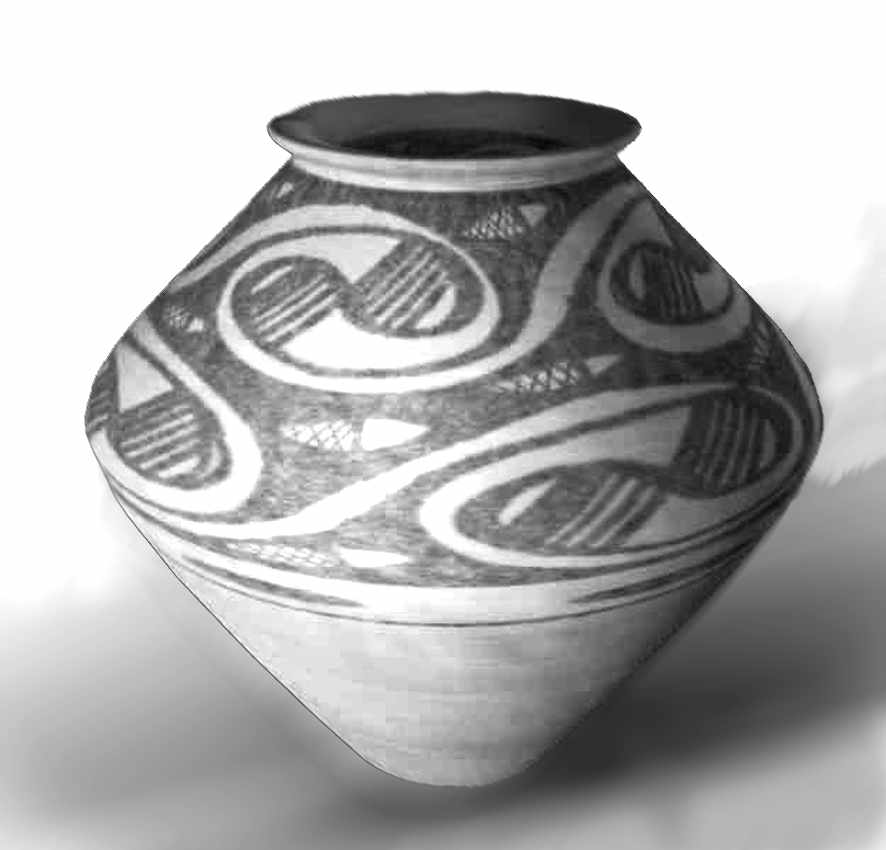 Folklore also records an interesting structure of the features of the sky, namely: the highest sky consists of three layers of unknown matter, and the distance between them is twelve times greater than the distance from the earth to the first heavens. The works of folklorist V. Hnatyuk provide a detailed idea of the edge of the world, the place where heaven and earth converge. In the minds of some, it was believed that no one alive had ever been to this place, so a strong and fierce people lived there, others claimed that at the edge of the world when women wash their laundry, they put their laundry in the sky, and according to the beliefs of others, the soul of a person after death flies to the edge of the world, to where Heaven begins.
Folklore also records an interesting structure of the features of the sky, namely: the highest sky consists of three layers of unknown matter, and the distance between them is twelve times greater than the distance from the earth to the first heavens. The works of folklorist V. Hnatyuk provide a detailed idea of the edge of the world, the place where heaven and earth converge. In the minds of some, it was believed that no one alive had ever been to this place, so a strong and fierce people lived there, others claimed that at the edge of the world when women wash their laundry, they put their laundry in the sky, and according to the beliefs of others, the soul of a person after death flies to the edge of the world, to where Heaven begins.
The knowledge of the world by the ancient inhabitants of the earth is sometimes distinguished by the binary opposition of Heaven and Earth, as the principle of male and female, active and passive, top and bottom. Such a pair was at the same time perceived as heavenly and the parents of man. If we pay attention to cosmogonic myths, the appearance of Heaven is described as a "figure" from chaos, in Ukrainian mythology the sky arises from an egg or a vessel, and from the sacred marriage of Heaven and Earth life is born in the Universe. As already noted, the center of the world is the Tree of Life, but there is another variation of such a symbol, namely the high World Mountain, the top of which holds the Sky on which the Gods live. An echo of such a mountain is the belief of Ukrainians that heaven is a kind of mountain on the top of which mortals meet God. An interesting and original crystal-model of the universe is the traditional Ukrainian straw spider.
An interesting point in the worldview of the people is the theme of people's journey to heaven, as well as the bringing or gifting of earthly goods by mythical heroes or the gods themselves. This is the appearance of fire and teaching crafts and tillage. Heaven in this context was viewed by the ancestors not just as a home for the Divine Forces, but also as a place where people return after death - paradise. Such a view of Heaven was an important element in the formation and preservation of the cult of ancestors.
 The Sun was considered a symbol of heavenly spirituality, the personification of individual gods, the center of the world and the source of life. The cult of this celestial body was one of the key and universal. In the Ipatiev Chronicle, dated 1114, it is indicated that the Sun is the son of Svarog and is Dazhbog, however, according to some other sources, Svarog was considered the god of the sun. According to the observations of V. Shayan, the original name of the highest Heaven sounded like "Svarog" and "Svar" and was a sacred word and sound. The folklorist also records a poetic and mythological attitude towards the Sun, which is endowed with constant epithets: righteous, holy, beautiful, clear, beautiful. Later, the Sun will take its own separate place next to the Almighty, such a change is clearly visible from the carol, at which three companions are sitting at the table - the bright sun, the clear moon and the Heavenly God himself. Confirmation of this attitude to the sun as a separate force is the teaching of Vladimir Monomakh, according to which it is necessary to give morning praise to God, and then to the rising sun. However, the Sun was also considered one of the hypostases of the Almighty, so the Grand Duke taught that when you see the sun, you should glorify God with joy. Therefore, it is not by chance that a solar eclipse was perceived as the abduction of the luminary by dark forces and foreshadowed misfortunes and troubles. Quite noteworthy is the fact that in Christianity Jesus appears as the Sun of Truth, and the Kiev prince Volodymyr Svyatoslavich was popularly christened with a metaphorically filled nickname - "Red Sun".
The Sun was considered a symbol of heavenly spirituality, the personification of individual gods, the center of the world and the source of life. The cult of this celestial body was one of the key and universal. In the Ipatiev Chronicle, dated 1114, it is indicated that the Sun is the son of Svarog and is Dazhbog, however, according to some other sources, Svarog was considered the god of the sun. According to the observations of V. Shayan, the original name of the highest Heaven sounded like "Svarog" and "Svar" and was a sacred word and sound. The folklorist also records a poetic and mythological attitude towards the Sun, which is endowed with constant epithets: righteous, holy, beautiful, clear, beautiful. Later, the Sun will take its own separate place next to the Almighty, such a change is clearly visible from the carol, at which three companions are sitting at the table - the bright sun, the clear moon and the Heavenly God himself. Confirmation of this attitude to the sun as a separate force is the teaching of Vladimir Monomakh, according to which it is necessary to give morning praise to God, and then to the rising sun. However, the Sun was also considered one of the hypostases of the Almighty, so the Grand Duke taught that when you see the sun, you should glorify God with joy. Therefore, it is not by chance that a solar eclipse was perceived as the abduction of the luminary by dark forces and foreshadowed misfortunes and troubles. Quite noteworthy is the fact that in Christianity Jesus appears as the Sun of Truth, and the Kiev prince Volodymyr Svyatoslavich was popularly christened with a metaphorically filled nickname - "Red Sun".
In folk songs and carols, the sun, moon, and stars are personified and acquire spiritual features, presented as a single family, where the sun is a woman and mother, the moon is a man and father, and the stars are their children. In the Ukrainian mythopoetic tradition, the sun was depicted in the images of a "mother," a "red maiden," and a "princess," that is, it was filled with feminine features. P. Chubynsky recorded a Ukrainian carol in which it is described as the Sun, in the image of a goddess-maiden, dresses behind a golden wall (the wall acts as an image of the red-golden sky at dawn). In the folk imagination, the sun "dances," "plays," and "marries." The entrance doors in homes and altars in temples were oriented to the east precisely in honor of the sun.
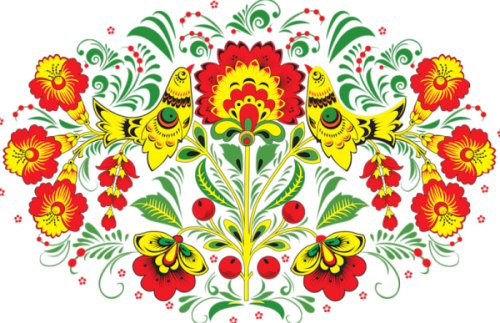 Ukrainian rituals have preserved the signs of the cult of the Sun to this day, the images of which are depicted and symbolized in traditional and ritual pastries: various loaves, palyanitsa, kalyty, cookies; in pysanka and krashanka; in the decoration of clay dishes, especially those used in ritual actions; in women's headdresses and girls' wreaths with ribbons (a wreath with bright ribbons personified the multifaceted manifestation of light and the Rainbow); in belts, jewelry and various rites and customs when celebrating key Ukrainian holidays: Christmas, Easter, Maslenitsa, Kupala and other calendar and family holidays.
Ukrainian rituals have preserved the signs of the cult of the Sun to this day, the images of which are depicted and symbolized in traditional and ritual pastries: various loaves, palyanitsa, kalyty, cookies; in pysanka and krashanka; in the decoration of clay dishes, especially those used in ritual actions; in women's headdresses and girls' wreaths with ribbons (a wreath with bright ribbons personified the multifaceted manifestation of light and the Rainbow); in belts, jewelry and various rites and customs when celebrating key Ukrainian holidays: Christmas, Easter, Maslenitsa, Kupala and other calendar and family holidays.
The image of the Moon - "the night eye of God" together with the Sun was deeply revered. Thus, there was a tradition on the new moon to pronounce special spells for well-being, health, happiness and order. The Moon occupied a special place in the traditions of Ukrainian medicine and molfarism, due to its cyclical nature and magnetism. The cult of this planet became the founder of lunar mythology, with its opposition of light and darkness, active male and passive female principles (a kind of analogy with the Chinese concepts of "yin and yang"). According to the monograph of ethnopsychologist V. Kuyevd, dumplings and actions with a goat, which are an integral attribute of the celebration of the Generous Evening - the holiday of the birth of the Moon, which our ancestors called Grandfather or Grandfather.
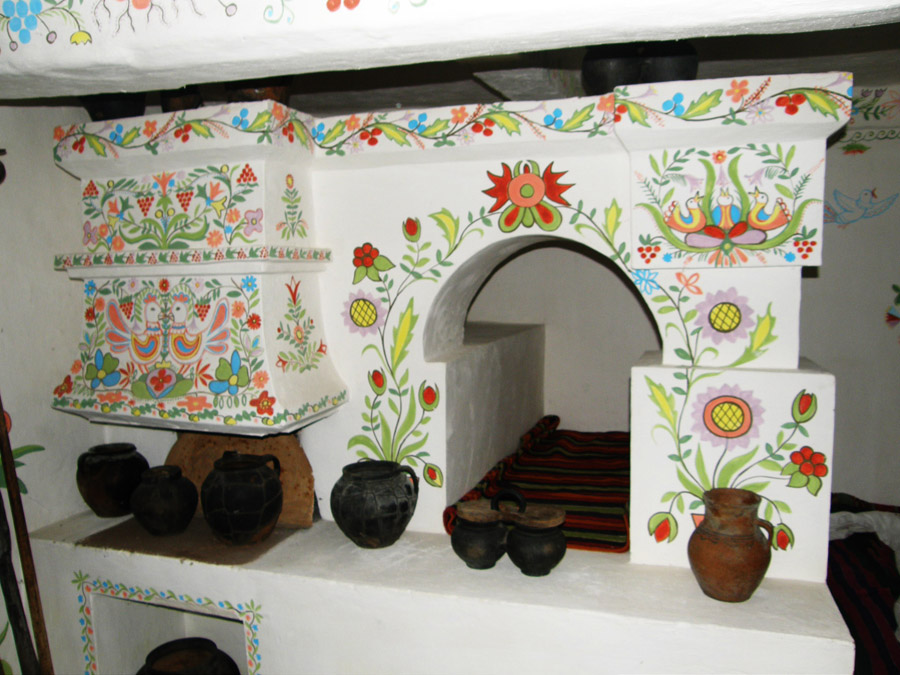 Everything related to the sky played a special and important role in the life of a person of that time, and the stars were no exception. As a rule, they appeared in the form of children or sisters of the Sun, and sometimes acted as the souls of people. In Ukrainian culture, there is even a goddess, Zorya, who, in the form of a young maiden, is related to dew and heavenly moisture. There is a constant phraseology among the people, which speaks of a “beautiful maiden” who entered the church and “rose like a dawn” and “shone”. A special role was also assigned to large clusters of stars, such as “families” of stars, such as the Milky Way. Such ideas have survived to the present day in Ukrainian culture and are often used in villages in sayings when baking the same wedding ritual loaves.
Everything related to the sky played a special and important role in the life of a person of that time, and the stars were no exception. As a rule, they appeared in the form of children or sisters of the Sun, and sometimes acted as the souls of people. In Ukrainian culture, there is even a goddess, Zorya, who, in the form of a young maiden, is related to dew and heavenly moisture. There is a constant phraseology among the people, which speaks of a “beautiful maiden” who entered the church and “rose like a dawn” and “shone”. A special role was also assigned to large clusters of stars, such as “families” of stars, such as the Milky Way. Such ideas have survived to the present day in Ukrainian culture and are often used in villages in sayings when baking the same wedding ritual loaves.
Ukrainian household items have long been decorated with various ornaments full of worldview semantics. These ornaments compositionally consist of the most typical and most common elements of the archetypal plan such as: dots, curves, zigzags, straight and spiral lines, curls, circles, crosses, etc. Among the main groups and types of ornaments (researchers distinguish plant, geometric, zoomorphic and anthropomorphic ornaments), a group of symbols denoting celestial bodies can be separately distinguished: the moon, stars, sun. Such cosmic symbols are closely intertwined and mixed with the main ornamental symbols and motifs. When using cosmic symbols, the main and central place is, of course, occupied by astral signs and images of the sun, moon, celestial fire and stars, which over time were transformed into floral images. The widespread use of cosmic-floral symbols can be attributed to Henri Brocard, who at the end of the 19th century widely disseminated patterns for embroidery with such cosmopolitan “roses” (a separate trend in Brocar embroidery was even created based on those patterns). However, S. Kolos insisted that the late ornamental motif of the “full rose” was not of plant origin, but derived from the sun or stars and contained solar symbolism.
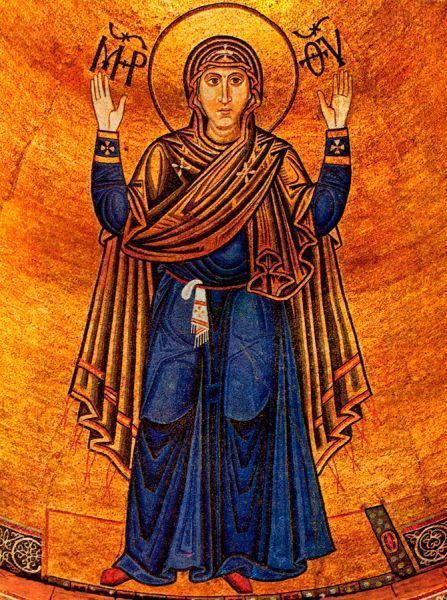 In contrast to modernized ones, ancient Ukrainian artifacts were full of dynamic compositions that attempted to recreate a vortex-like movement in a circle using central supports – various spirals, rosettes, svarga, circles, etc. The most famous and familiar symbols of such movement and worldview – waves, spirals, zigzags, meanders, parallel notches – are constantly found in folk patterns and ornaments, and are similar to the generally accepted signs of fixation of celestial bodies in the Universe.
In contrast to modernized ones, ancient Ukrainian artifacts were full of dynamic compositions that attempted to recreate a vortex-like movement in a circle using central supports – various spirals, rosettes, svarga, circles, etc. The most famous and familiar symbols of such movement and worldview – waves, spirals, zigzags, meanders, parallel notches – are constantly found in folk patterns and ornaments, and are similar to the generally accepted signs of fixation of celestial bodies in the Universe.
Contemplating such ornaments, one cannot help but recall the Trypillian system of ornaments, in which a clearly expressed cosmogonic symbolism is traced. Thus, according to the research of several scientists (Yu. Lypa, L. Chykalenko, V. Shcherbakivsky), the oldest elements of the Ukrainian ornament are svarga - the sign of Svarog and the infinity, which over time transformed into a meander. Trypillian ornamentation is characterized by combinations of the master's artistic idea with important and profound concepts of the worldview of the mythology of the Indo-European peoples. The dominant motifs in such an ornamental tradition are: the symbol of the Sun in the form of a bull or a combination of horns, quite often a disk of the Sun was depicted between the horns; the image of the Great Mother-Goddess in the form of a female figure; the symbol of the Universe was presented in the form of a three-plan image of the earth, fertility (the image of the Mother-Goddess) and the sky (the image of the Sun-bull).
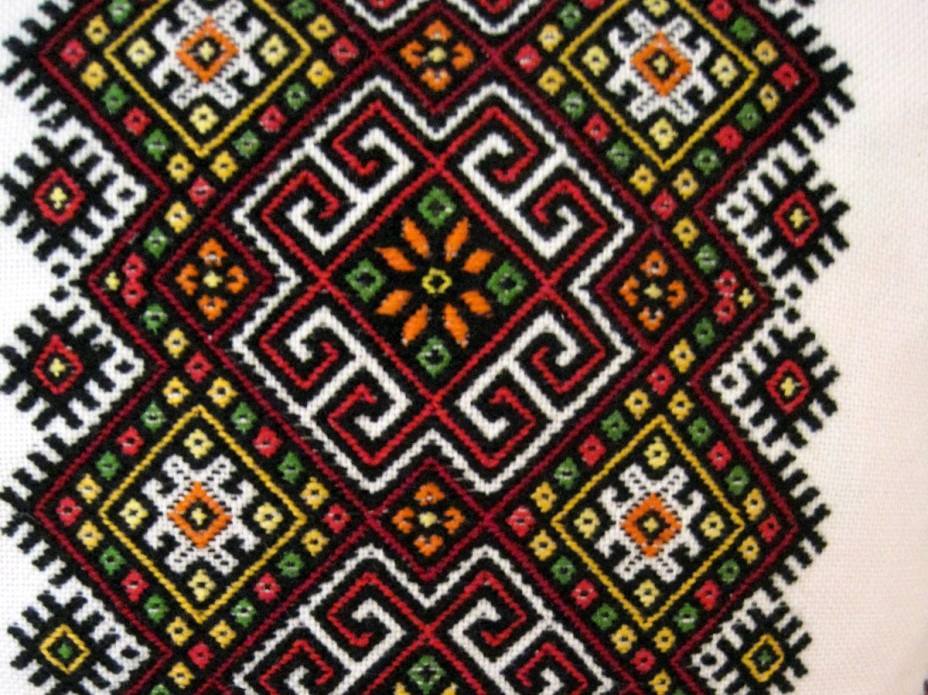 In the cultures of different peoples, the Sun in the form of a geometric representation was usually depicted as a circle with a dot in the middle, and the Earth, on the contrary, was symbolized by a square. Various "solar disks", that is, ornamental images of crosses in a circle, are related to the symbolism of the sun and fire. Such solar signs quite often find a place in artistic expressions on the canvases of carpets or towels, on embroidered shirts, when decorating wooden objects with carvings, painting Easter eggs, interiors of Ukrainian homes, gravestone signs, and others.
In the cultures of different peoples, the Sun in the form of a geometric representation was usually depicted as a circle with a dot in the middle, and the Earth, on the contrary, was symbolized by a square. Various "solar disks", that is, ornamental images of crosses in a circle, are related to the symbolism of the sun and fire. Such solar signs quite often find a place in artistic expressions on the canvases of carpets or towels, on embroidered shirts, when decorating wooden objects with carvings, painting Easter eggs, interiors of Ukrainian homes, gravestone signs, and others.
An important and noticeable element in Ukrainian ornamentalism, which has survived to the present day, is the cross. Moreover, the cross acts not only as a symbol of fertility, but also as an aspect of the interpretation of the masculine principle and heavenly protection. Crosses as the most ancient astral-cosmic symbols are found on the monuments of the Bug-Dniester culture of the Proto-Neolithic and Neolithic periods. It should be noted that in this context, the vertical line is associated with the paternal-masculine principle, and the horizontal one, respectively, with the maternal-feminine principle, therefore, the intersection of these two universal principles gives the simplest model of the World, the center of which is the convergence of Heaven and Earth.
The use of the cross as a symbol in ornaments is quite wide, from a simple designation of life, energy, the sun or happiness to an important Christian symbol of the crucifixion of Jesus and a symbol of the cosmic Christ. Interestingly, however, early Christians and representatives of other cultures up to the 4th millennium AD considered it a symbol of sun worship and paganism. The graphic manifestation of the four-pointed cross has its continuation in eight- and six-rayed stars, symbolizing various astral talas in the sky and the victory of light over darkness. Often such "stars" became amulets in the life of our ancestors. According to the observations of archaeologist V. Shcherbakivsky, the main motifs and elements of the ornaments "sun rings", "stars", "eyes", courts are found on the ceramics of the Near East peoples of the Neolithic period, and later on Greek terracotta, had their own deep magical meaning, served as signs and symbols of deities and magical apotropaic signs. It is precisely such functions as a certain echo of the cult of the sun and as certain amulets that are inherent in the solar motifs of Ukrainian ornaments depicted on various works of folk decorative and applied art.
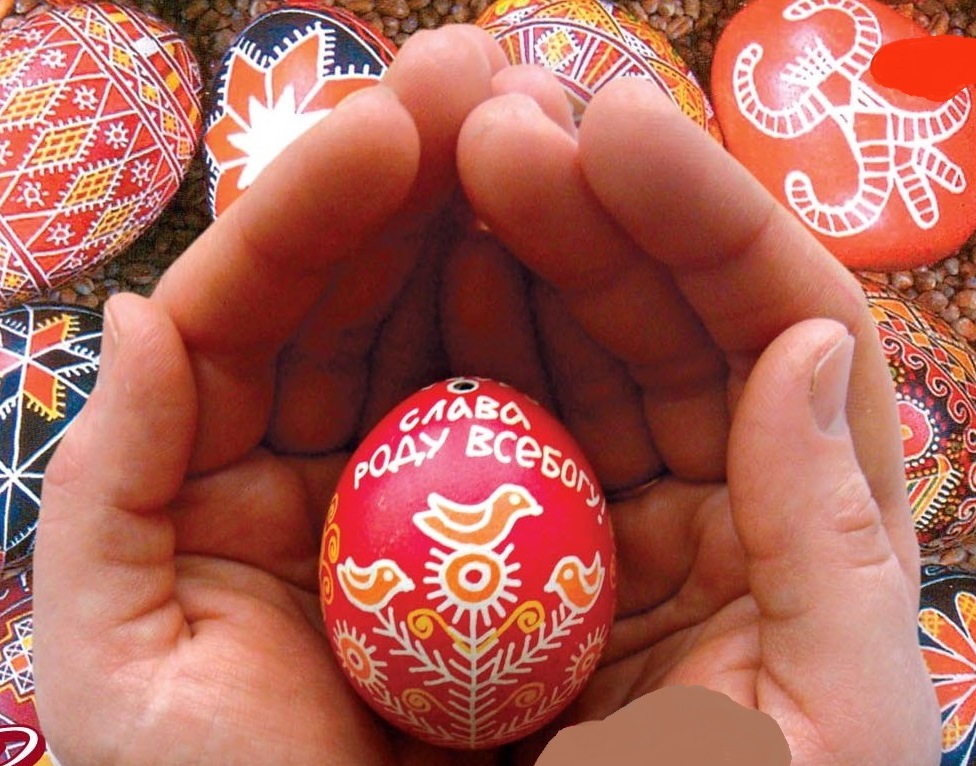 So, summing up all the above, we can conclude that the disclosure of the semantic meaning of ornaments is possible only through the study of mythological sources, reconstructions of religious and social ideas and beliefs of a particular era and a detailed study of elements of ritual and archaic cults. For centuries, symbolism and ways of depicting certain events and beliefs were passed down from generation to generation without undergoing other influences and changes, but over time, symbolism and sacred meaning became increasingly simplified. Therefore, a deep analysis of the traditional symbolism of the people leads, first of all, to the knowledge and understanding of their folk culture, and only then to the study of the primary semantic meanings of symbols. In this context, the mythopoetic visions and ideas of our ancestors are confirmed by modern cosmogonic concepts and hypotheses, and testify to the cultural originality and spiritual uniqueness of the Ukrainian romantic nature.
So, summing up all the above, we can conclude that the disclosure of the semantic meaning of ornaments is possible only through the study of mythological sources, reconstructions of religious and social ideas and beliefs of a particular era and a detailed study of elements of ritual and archaic cults. For centuries, symbolism and ways of depicting certain events and beliefs were passed down from generation to generation without undergoing other influences and changes, but over time, symbolism and sacred meaning became increasingly simplified. Therefore, a deep analysis of the traditional symbolism of the people leads, first of all, to the knowledge and understanding of their folk culture, and only then to the study of the primary semantic meanings of symbols. In this context, the mythopoetic visions and ideas of our ancestors are confirmed by modern cosmogonic concepts and hypotheses, and testify to the cultural originality and spiritual uniqueness of the Ukrainian romantic nature.


Write a comment